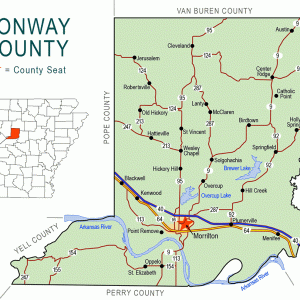calsfoundation@cals.org
St. Vincent (Conway County)
The community of St. Vincent sits on Pigeon Roost Mountain in Conway County. St. Vincent township had an estimated population of 520 in 2022. The area is home to many farms and the Wonderview School District.
Pigeon Roost Mountain spans 11,000 acres, with an elevation of over 700 feet. The mountain runs east to west with the western boundary ending in steep drop-offs, while the eastern boundary is marked with creeks such as Prairie Creek and Point Remove Creek. The mountain gets its name from the flocks of passenger pigeons that used to roost on the cliffs and trees during the early settlement period. The land was part of a Cherokee reservation from 1817 to 1828. The reservation was bought by the federal government in 1828, and the Cherokee were removed to what is now Oklahoma.
In 1878, the Little Rock and Fort Smith Railroad granted several hundred thousand acres of land to the St. Joseph Colony, a project of Father Joseph Strub to promote the settlement of Catholic immigrants to the area. In 1879, St. Vincent’s first settlers, John and Philippina Beck, arrived from Pennsylvania, with their two sons, Joseph and Adolph Beck. John was born in Germany, while Philippina was born in the United States. That same year, Frank J. Noll and his family arrived from Pennsylvania and Lawrence Gunderman and his family came from Ohio.
Fr. Strub, who had been expelled from Germany by Chancellor Otto Von Bismarck of Prussia, wanted to help other Germans and Europeans fleeing Bismarck’s anti-Catholic policy of the Kulturkampf. In 1880, Strub wrote a pamphlet called “The Guiding Star of St. Joseph Colony,” hoping to encourage more immigrants to settle the land between Marche (Pulaski County) and Atkins (Pope County) on the northern side of the Arkansas River. The target audience was German, Swiss, and Austrian Catholics. This pamphlet must have reached many families in Europe because, by 1880, the Pfeifer, Gangluff, Koch, Hartman, and Kaufman families arrived at Pigeon Roost from Germany and Switzerland. In 1883, other families arrived from Switzerland. The last family to arrive from Europe was the Andres family, who came from Switzerland in 1924.
The community was named St. Vincent in honor of the original community in Pennsylvania also called St. Vincent. Most of the settlers were Roman Catholic, and the first structure in the small town was a well that could support the future church. This well was hand dug by the men of the community and still exists in the twenty-first century.
By 1880, the first church, named St. Mary’s, was built with financial aid from Amond Fierle of Pittsburgh and with help from Lawrence Gunderman and John Post. Fierle also donated the first bell for the church. In 1881, the first resident pastor, Rev. John Otto, was stationed at St. Vincent. Otto established the St. Vincent Catholic School and a rectory. One general store, which also housed a post office for a time, was located in the community. Settlers had to travel ten miles south to Morrilton (Conway County) by horse and buggy if items were not available in the store. The prime means of support for families was farming. This included cotton, hay, livestock, and sorghum molasses. By 1915, the first automobile in the community was owned by Frank Berkemeyer.
Life of the Catholic community was centered around the church and its activities. Benedictine nuns came to the community in 1902 to teach at the local parochial school; they were recalled in 1968. In 1930–31, the present-day church was built.
In 1936, S. D. Flent bought the last piece of available land on the mountain. He established a large farm where the community of St. Vincent would get many of its foods. The west end of the mountain was long called “Flent Mountain.”
With the opening of a new public school in 1934 and the consolidation of schools in Conway County, the church school was gradually shut down; it was completely dissolved in 1968, and many of the students began attending school in the Wonderview District. In the twenty-first century, the church centers many community activities, and the community is known for its Fourth of July parade.
For additional information:
Centennial Historical Committee of St. Vincent: Our Lady of Perpetual Help: St. Mary’s Parish, 1880–1980. St. Vincent, AR: Poindexter Printing & Office Supplies, 1980.
Conway County Historical Society. Our Land, Our Home, Our People. Little Rock: Historical Publications of Arkansas, 1989.
Heffington, D. Prehistory of Conway County. Little Rock: American Indian Center of Arkansas, 1989.
Seth Rees
St. Vincent, Arkansas






I have records of both sides of my family arriving in St. Vincent, Arkansas, in 1882. Joseph and Alois Ambort from Valais Visperterminen, Switzerland, came on ship le France from Le Havre Port in France. Also the Briggeler family: Peter and Karolina Shanz-Briggeler with six children–Bernhard, Maria, Katherine, Philomena, Elizabeth, and Petrus. The two Ambort brothers mentioned here were on same ship same day from same city and got married four years later in St. Vincent, Arkansas. Later census records show they sold land and moved to Little Rock, Arkansas. Fouche dam pike area. Later near the German Catholic Church on Ninth Street. Later to North Little Rock.
Paul Binz–Two branches of my family settled here as well: the Amborts and the Briggelers. Elizabeth Briggeler is my great-grandmother!
Two branches of my ancestors from Switzerland, the Ambort and the Briggeler families, settled in St. Vincent during this period.